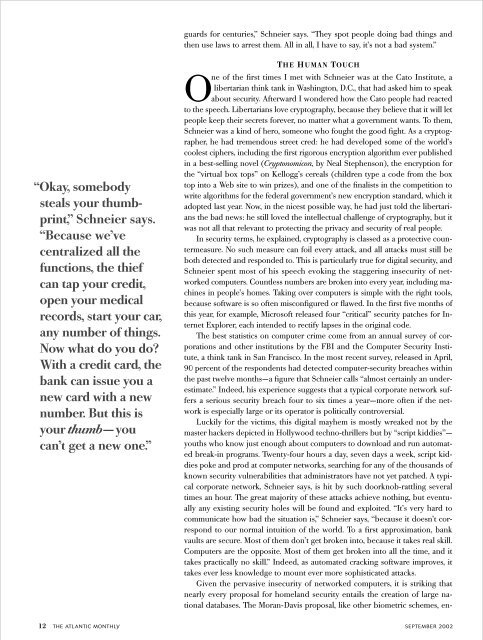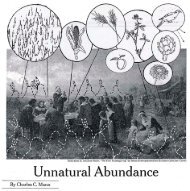HOMELAND INSECURITY - Charles C. Mann
HOMELAND INSECURITY - Charles C. Mann
HOMELAND INSECURITY - Charles C. Mann
Create successful ePaper yourself
Turn your PDF publications into a flip-book with our unique Google optimized e-Paper software.
Sept-Insecurity.pages 6/28/02 10:37 AM Page 12<br />
“Okay, somebody<br />
steals your thumbprint,”<br />
Schneier says.<br />
“Because we’ve<br />
centralized all the<br />
functions, the thief<br />
can tap your credit,<br />
open your medical<br />
records, start your car,<br />
any number of things.<br />
Now what do you do?<br />
With a credit card, the<br />
bank can issue you a<br />
new card with a new<br />
number. But this is<br />
yourthumb—you<br />
can’t get a new one.”<br />
guards for centuries,” Schneier says. “They spot people doing bad things and<br />
then use laws to arrest them. All in all, I have to say, it’s not a bad system.”<br />
THE H UMAN TOUCH<br />
One of the first times I met with Schneier was at the Cato Institute, a<br />
libertarian think tank in Washington, D.C., that had asked him to speak<br />
about security. Afterward I wondered how the Cato people had reacted<br />
to the speech. Libertarians love cryptography, because they believe that it will let<br />
people keep their secrets forever, no matter what a government wants. To them,<br />
Schneier was a kind of hero, someone who fought the good fight. As a cryptographer,<br />
he had tremendous street cred: he had developed some of the world’s<br />
coolest ciphers, including the first rigorous encryption algorithm ever published<br />
in a best-selling novel (Cryptonomicon, by Neal Stephenson), the encryption for<br />
the “virtual box tops” on Kellogg’s cereals (children type a code from the box<br />
top into a Web site to win prizes), and one of the finalists in the competition to<br />
write algorithms for the federal government’s new encryption standard, which it<br />
adopted last year. Now, in the nicest possible way, he had just told the libertarians<br />
the bad news: he still loved the intellectual challenge of cryptography, but it<br />
was not all that relevant to protecting the privacy and security of real people.<br />
In security terms, he explained, cryptography is classed as a protective countermeasure.<br />
No such measure can foil every attack, and all attacks must still be<br />
both detected and responded to. This is particularly true for digital security, and<br />
Schneier spent most of his speech evoking the staggering insecurity of networked<br />
computers. Countless numbers are broken into every year, including machines<br />
in people’s homes. Taking over computers is simple with the right tools,<br />
because software is so often misconfigured or flawed. In the first five months of<br />
this year, for example, Microsoft released four “critical” security patches for Internet<br />
Explorer, each intended to rectify lapses in the original code.<br />
The best statistics on computer crime come from an annual survey of corporations<br />
and other institutions by the FBI and the Computer Security Institute,<br />
a think tank in San Francisco. In the most recent survey, released in April,<br />
90 percent of the respondents had detected computer-security breaches within<br />
the past twelve months—a figure that Schneier calls “almost certainly an underestimate.”<br />
Indeed, his experience suggests that a typical corporate network suffers<br />
a serious security breach four to six times a year—more often if the network<br />
is especially large or its operator is politically controversial.<br />
Luckily for the victims, this digital mayhem is mostly wreaked not by the<br />
master hackers depicted in Hollywood techno-thrillers but by “script kiddies”—<br />
youths who know just enough about computers to download and run automated<br />
break-in programs. Twenty-four hours a day, seven days a week, script kiddies<br />
poke and prod at computer networks, searching for any of the thousands of<br />
known security vulnerabilities that administrators have not yet patched. A typical<br />
corporate network, Schneier says, is hit by such doorknob-rattling several<br />
times an hour. The great majority of these attacks achieve nothing, but eventually<br />
any existing security holes will be found and exploited. “It’s very hard to<br />
communicate how bad the situation is,” Schneier says, “because it doesn’t correspond<br />
to our normal intuition of the world. To a first approximation, bank<br />
vaults are secure. Most of them don’t get broken into, because it takes real skill.<br />
Computers are the opposite. Most of them get broken into all the time, and it<br />
takes practically no skill.” Indeed, as automated cracking software improves, it<br />
takes ever less knowledge to mount ever more sophisticated attacks.<br />
Given the pervasive insecurity of networked computers, it is striking that<br />
nearly every proposal for homeland security entails the creation of large national<br />
databases. The Moran-Davis proposal, like other biometric schemes, en-<br />
12 THE ATLANTIC MONTHLY SEPTEMBER 2002




